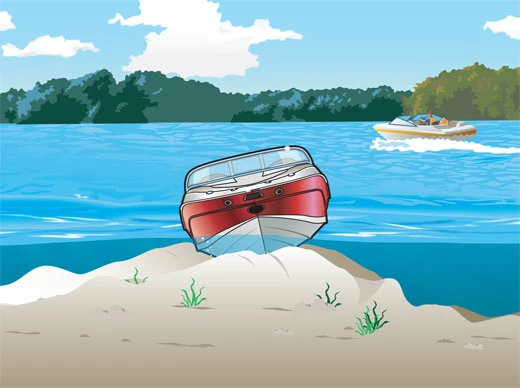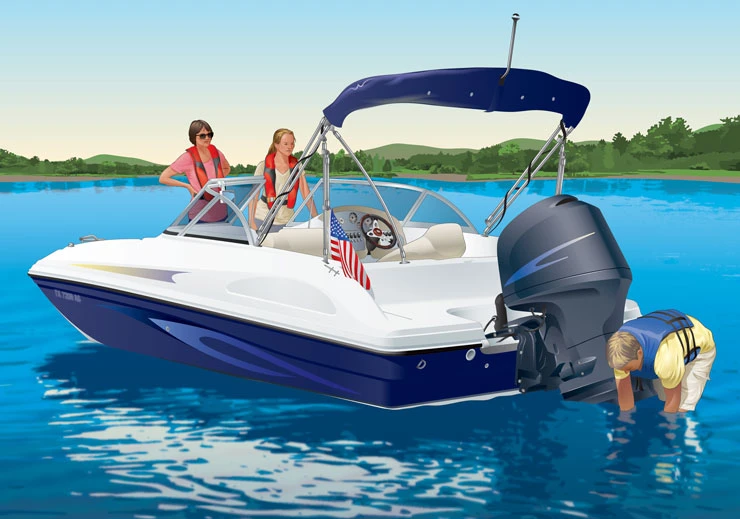
(image provided courtesy of boat-ed.com)
What Should You Do If Your Boat Runs Aground? Here’s everything you need to know:
Introducing our comprehensive guide on what to do if your boat runs aground. This guide contains answers to the boating test questions for new boaters as well as general information that every boater should know. Navigating the waters can sometimes lead to unexpected challenges, and running aground is a situation every boater hopes to avoid. In this article, we’ll delve into the essential steps to take if your vessel finds itself stuck on the bottom. From immediate safety checks to strategic maneuvers, we’ll equip you with the knowledge to handle this common boating mishap effectively. So, whether you’re a seasoned sailor or new to boating, read on to learn how to navigate through the unexpected when your boat runs aground.
Table of Contents
- What should you do first if your boat runs aground?
- What should you do after your boat runs aground and you determine that there are no leaks?
- Your boat runs aground at high speed. What should you do first?
- What should you do if you run aground in an outboard boat?
- What should you do if you run aground in an outboard boat and you are not taking on water?
- What should you do if you run aground and your boat has serious damage?
- If your boat runs aground on a sand bar during low tide, what actions should the boat operator take?
- If you run your boat aground, what should you do first?
- Check out our other study guides for boating test questions:
- Getting Certified: Passing your boat exam
In addition to addressing what to do if your boat runs aground, we’ll also cover various other scenarios crucial for boating safety and preparedness. From understanding the different types of marine distress signals to knowing how to handle engine failure or unexpected weather changes, we’ve got you covered when there’s boats running aground. Whether you’re studying for your boating test or simply aiming to enhance your boating knowledge, our comprehensive guide will provide valuable insights to keep you safe and confident on the water. So, let’s dive in and explore the essential skills and knowledge every boater should possess for a safe and enjoyable experience.
What should you do first if your boat runs aground?
If your boat runs aground, the first step is to ensure that no one onboard is injured. After confirming everyone’s safety, check for any signs of leaks or damage to the hull. It’s essential to address any potential risks to the boat’s integrity before attempting to free it from the grounding. Knowing what should you do first if your boat runs aground may seem easy now, but once you’re on the water the situation can become stressful quickly. What should you do first if your boat runs aground? Be safe, check for leaks, and call for help.
What should you do after your boat runs aground and you determine that there are no leaks?
If your boat runs aground and you’ve confirmed that there are no leaks or immediate risks to safety, you can proceed with attempting to free the vessel. If your boat ran aground, here’s what to do next:
- Stop the Engine: Cease engine operation to prevent further grounding or damage.
- Lift the Outdrive: Instead of using reverse, lift the outdrive to disengage the propeller and minimize the risk of damage.
- Shift Weight: Move weight to the area farthest away from the point of impact. This redistribution can help tilt the boat and facilitate dislodging it from the grounding.
- Shove Off: Utilize a paddle or boathook to gently push the boat off the obstruction, such as rocks, the bottom, or a reef. Exercise caution to avoid causing further damage to the vessel.
- Monitor for Leaks: Continuously monitor the boat for any signs of taking on water or structural damage. If any issues arise, take appropriate measures to address them promptly.
- Call for Assistance: If attempts to free the boat are unsuccessful or if there are concerns about safety, use visual distress signals and a VHF marine radio to summon assistance. Professional help may be needed to safely refloat the vessel.
By following these steps, you can effectively address the situation and work towards safely freeing your boat from aground conditions. If you’re studying for a boat certification or captains test, be prepared for multiple-choice questions similar to what should you do after your boat runs aground and you determine that there are no leaks. Many times the answer is around calling for help, or safely trying to dislodge your vessel.
Your boat runs aground at high speed. What should you do first?
If your boat runs aground at high speed, the safety of everyone onboard is paramount. If your boat runs aground at high speed, here’s what you should do first:
- Ensure Safety: Immediately assess the situation to ensure the safety of all passengers onboard. Check for any injuries and provide assistance as needed.
- Check for Leaks: Quickly inspect the boat for any signs of damage or leaks. If water is entering the vessel, take immediate action to address the situation and prevent further flooding.
- Stop the Engine: Shut off the engine to prevent further propulsion and potential damage to the vessel or individuals nearby.
- Assess the Damage: Carefully evaluate the extent of the grounding and any damage sustained by the boat. This assessment will help determine the best course of action for safely refloating or securing the vessel.
- Deploy Safety Equipment: If necessary, deploy appropriate safety equipment such as life jackets, distress signals, and communication devices to ensure readiness for any further assistance needed.
- Call for Help: If the situation warrants it or if you’re unable to refloat the boat on your own, use a VHF marine radio or other communication devices to call for assistance from authorities or nearby vessels.
If your boat runs aground at high-speed, it can be a startling situation. Taking these steps promptly and effectively will help mitigate risks and ensure the safety of everyone involved in the incident. Boat Tests will ask this question in many different ways including your boat runs aground at high-speed what should you do first and your boat runs aground at high speed. what should you do first?

(image provided courtesy of boat-ed.com)
What should you do if you run aground in an outboard boat?
If you run aground in an outboard boat, or you are trying to free an outboard boat that has run aground, follow these steps:
- Ensure Safety: First and foremost, ensure the safety of all passengers onboard. Check for injuries and address any immediate medical needs.
- Assess the Situation: Evaluate the extent of the grounding and assess whether there are any signs of damage or leaks to the boat.
- Shift Weight: If it’s safe to do so, redistribute the weight onboard to help lighten the vessel and potentially free it from the obstruction.
- Check for Leaks: Inspect the hull for any signs of damage or water ingress. If there are leaks, take immediate action to address them and prevent further flooding.
- Attempt to Refloat: If the boat is not severely stuck and there are no leaks, attempt to refloat it by rocking it gently back and forth while using the engine in reverse.
- Use Oars or Paddles: If the outboard engine cannot free the boat, use oars or paddles to try to push the boat off the obstruction.
- Call for Assistance: If efforts to free the boat are unsuccessful or if there are safety concerns, call for assistance using a marine radio or mobile phone.
- Deploy Safety Equipment: Ensure that all necessary safety equipment, including life jackets and distress signals, are readily accessible in case they are needed.
Remember to stay calm and avoid making sudden or erratic movements that could exacerbate the situation. Remember that boats running aground can happen anywhere. If you’re unable to free the boat on your own, it’s essential to seek assistance promptly to ensure the safety of everyone onboard.
What should you do if you run aground in an outboard boat and you are not taking on water?
If you run aground in an outboard boat and are not taking on water, or you are trying to free an outboard boat that has run aground, follow these steps:
- Assess the Situation: Take a moment to evaluate the extent of the grounding and assess whether there are any signs of damage or leaks to the boat.
- Shift Weight: If it’s safe to do so, redistribute the weight onboard to help lighten the vessel and potentially free it from the obstruction.
- Attempt to Refloat: Try to refloat the boat by rocking it gently back and forth while using the outboard engine in reverse.
- Use Oars or Paddles: If the outboard engine alone cannot free the boat, use oars or paddles to try to push the boat off the obstruction.
- Call for Assistance: If efforts to free the boat are unsuccessful or if there are safety concerns, call for assistance using a marine radio or mobile phone.
- Deploy Safety Equipment: Ensure that all necessary safety equipment, including life jackets and distress signals, are readily accessible in case they are needed.
- Monitor the Situation: Keep a close eye on the boat’s condition and surroundings. If there are any changes or developments, adjust your actions accordingly.
By following these steps, you can increase the likelihood of safely freeing your outboard boat from aground without further complications. If you are trying to free an outboard boat that has run aground, remember this guide.
What should you do if you run aground and your boat has serious damage?
If your boat ran aground and your boat sustains serious damage, follow these steps:
- Ensure Safety: First and foremost, ensure the safety of everyone on board. Check for injuries and administer first aid if needed. If the situation is unsafe, prioritize getting everyone to a secure location.
- Assess Damage: Carefully assess the extent of the damage to your boat. Look for visible signs of hull damage, structural issues, or any other critical systems affected by the grounding.
- Address Immediate Threats: If there’s a risk of the boat taking on water or sinking, take immediate action to mitigate the threat. This may involve using onboard pumps to remove water or deploying emergency flotation devices.
- Secure the Boat: If possible, attempt to stabilize the boat to prevent further damage. This may involve deploying anchors or securing lines to nearby objects to keep the boat in place.
- Call for Assistance: Contact local authorities or marine services to report the incident and request assistance. Provide them with your location, the extent of the damage, and the number of people on board.
- Follow Emergency Procedures: Follow any specific emergency procedures outlined in your boat’s safety plan or manufacturer’s guidelines. This may include activating distress signals, such as flares or EPIRBs, to signal your need for help.
- Await Rescue: Stay with the boat and await rescue by authorities or assistance from other boaters. Avoid attempting to abandon the boat unless absolutely necessary, as it may be safer to remain on board until help arrives.
- Document the Incident: Take photos or videos of the damage and surrounding conditions for insurance purposes. Note any relevant details, such as the time and location of the grounding, and keep a record of communication with authorities or rescue services.
By following these steps, you can effectively respond to running aground and manage the situation, even in the event of serious damage to your boat.
If your boat runs aground on a sand bar during low tide, what actions should the boat operator take?
If your boat runs aground on a sandbar during low tide, the boat operator should take the following actions:
- Assess the Situation: Evaluate the extent of the grounding and determine if there are any immediate safety concerns for passengers or the vessel.
- Check for Damage: Inspect the hull and other critical components for any signs of damage or impact from the grounding. Look for leaks or structural issues that may compromise the boat’s seaworthiness.
- Shift Weight: If possible, redistribute the weight on board to help free the boat from the sandbar. This may involve moving passengers or cargo to adjust the vessel’s balance.
- Use Engine Power: Attempt to maneuver the boat off the sandbar by using engine power judiciously. Engage the engine in reverse to see if it helps dislodge the vessel from the obstruction.
- Wait for Rising Tide: If attempts to free the boat are unsuccessful, consider waiting for the tide to rise. As the water level increases, it may lift the boat off the sandbar, allowing you to safely navigate away. The Wavve Boating App is the easiest way to see tides near your current location
- Seek Assistance: If the boat remains stuck despite efforts to dislodge it, or if there are concerns about safety or damage, seek assistance from nearby boaters or marine services. Contact local authorities or a towing service for help if needed.
- Monitor Conditions: Keep a close eye on changing tide levels and environmental conditions while waiting for assistance or attempting to free the boat. Be prepared to adjust your strategy accordingly based on the situation.
By taking these actions, the boat operator can effectively respond to running aground on a sandbar during low tide and work towards safely freeing the vessel without causing further damage or endangering passengers.
If you run your boat aground, what should you do first?
If your boat runs aground, the first step is to assess the situation calmly. Ensure everyone on board is safe and not injured. Check the water depth around the boat to understand the extent of grounding. If possible, try to safely reverse off the obstruction using slow and steady throttle adjustments while keeping an eye on the depth gauge and water movement. If the boat remains stuck, consider shifting weight to help lift the hull or using an anchor to stabilize and wait for rising tides. Avoid excessive engine use to prevent damage and seek assistance if needed. Remember, if you run your boat aground what should you do first? Remain Calm and Safety On.
Check out our other study guides for boating test questions:
- What is draft on a boat?
- How to choose a marine gps app
- The 5 best boating weather apps for 2024.
Getting Certified: Passing your boat exam
Start your safe boating journey at boat-ed.com. Their accredited courses, recognized by NASBLA, the National Association of State Boating Law Administrators, make learning boater safety, etiquette, and water rules easy and accessible. With interactive courses available on all devices, prioritize safety as you prepare for your exam.
You can get a preview of what this, and other questions may look like on a boating test by visiting our friends at Boat-Ed. Check out their study guide.








